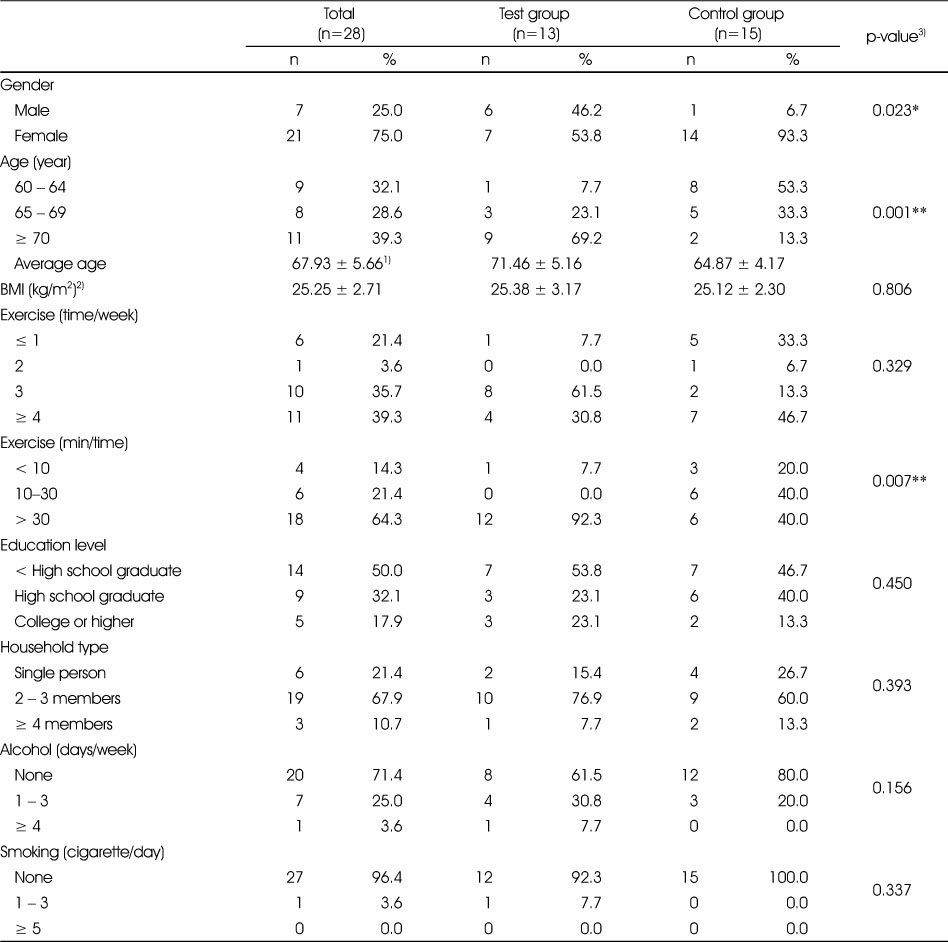Articles
- Page Path
- HOME > Korean J Community Nutr > Volume 24(6); 2019 > Article
-
Research Article
- Effects of Low-carbohydrate and High-fat Diet Supplemented with Ketogenic Drink on Cognitive Function and Physical Performance in the Elderly at High Risk for Dementia
-
Eun-Ji Kim
 , Jung-Sik Park
, Jung-Sik Park , Won-Sun Choi
, Won-Sun Choi , Yoo Kyoung Park
, Yoo Kyoung Park
-
Korean Journal of Community Nutrition 2019;24(6):525-534.
DOI: https://doi.org/10.5720/kjcn.2019.24.6.525
Published online: December 31, 2019
1Department of Medical Nutrition, Graduate School of East-West Medical Science, Kyung Hee University, Yongin, Korea, Student.
2Maeil Dairies Co., Ltd., Seoul, Korea, Researcher.
3MD wellI Inc, Seoul, Korea, Researcher.
4Department of Medical Nutrition, Graduate School of East-West Medical Science, Kyung Hee University, Yongin, Korea, Professor.
- Corresponding author: Yoo Kyoung Park. Department of Medical Nutrition, Graduate School of East-West Medical Science, Kyung Hee University, Yongin 17104, Korea. Tel: (031) 201-3816, Fax: (031) 203-3816, ypark@khu.ac.kr
Copyright © 2019 The Korean Society of Community Nutrition
This is an Open-Access article distributed under the terms of the Creative Commons Attribution Non-Commercial License (http://creativecommons.org/licenses/by-nc/3.0/) which permits unrestricted non-commercial use, distribution, and reproduction in any medium, provided the original work is properly cited.
- 1,059 Views
- 10 Download
- 1 Crossref
Figure & Data
REFERENCES
Citations

- To Keto or Not to Keto? A Systematic Review of Randomized Controlled Trials Assessing the Effects of Ketogenic Therapy on Alzheimer Disease
Maria G Grammatikopoulou, Dimitrios G Goulis, Konstantinos Gkiouras, Xenophon Theodoridis, Kalliopi K Gkouskou, Athanasios Evangeliou, Efthimis Dardiotis, Dimitrios P Bogdanos
Advances in Nutrition.2020; 11(6): 1583. CrossRef
Composition of nutrition drinks
1) Ketogenic ratio=Fat : Protein+Carbohydrate (g of ratio)
2) C : P : F=Carbohydrate : Protein:Fat (% of calorie)
General characteristics of study subjects
1) Values are means ± SD
2) BMI : Body mass index
3) Significantly different at p<0.05 by Chi-square test, independent t-test. *: p<0.05, **: p<0.01, ***: p<0.001
Personal and family disease history of risk factors for dementia
1) Other medical history included osteoporosis, stroke, parkinson's disease and hypotension.
2) Significantly different at p<0.05 by Chi-square test. **: p<0.01
3) NA : None applicable.
Adherence to the dietary intervention for low-carbohydrate and high-fat diet
Each nutrients standard was established in accordance with the LGIT (Low Glycemic Index treatment) for dietary compliance survey. All subjects had recorded daily number of serves from each of the 8 food groups including carbohydrate, protein, oil, vegetables, fruits, nuts, dairy products, and water. The above figures are the average intake of three weeks.
1) Values are means ± SD
Change in the Korean Mini-Mental State Examination (K-MMSE) score by each group
1) Values are means ± SD
2) Difference between baseline and 21 days
3) Significance as determined by paired t-test, Wilcoxon signed rank test (post hoc test).
4) Significant Time x Group interaction effect at p<0.05 by paired t-test.
*: p<0.05, **: p<0.01, ***: p<0.001
Changes in anthropometry and body composition by each group
1) Values are means ± SD
2) Difference between baseline and 10 days
3) Difference between 10 days and 21 days
4) Difference between baseline and 21 days
5) Significant Time x Group interaction effect at p<0.05 by paired t-test, Wilcoxon signed rank test (post hoc test).
*: p<0.05, **: p<0.01, ***: p<0.001
6) BMI : Body mass index
Changes in the physical fitness of daily living by each group
1) Values are means ± SD
2) Difference between baseline and 21 days
3) Significant Time x Group interaction effect at p<0.05 by paired t-test, Wilcoxon signed rank test (post hoc test).
*: p<0.05, **: p<0.01, ***: p<0.001
1) Ketogenic ratio=Fat : Protein+Carbohydrate (g of ratio) 2) C : P : F=Carbohydrate : Protein:Fat (% of calorie)
1) Values are means ± SD 2) BMI : Body mass index 3) Significantly different at p<0.05 by Chi-square test, independent t-test. *: p<0.05, **: p<0.01, ***: p<0.001
1) Other medical history included osteoporosis, stroke, parkinson's disease and hypotension. 2) Significantly different at p<0.05 by Chi-square test. **: p<0.01 3) NA : None applicable.
Each nutrients standard was established in accordance with the LGIT (Low Glycemic Index treatment) for dietary compliance survey. All subjects had recorded daily number of serves from each of the 8 food groups including carbohydrate, protein, oil, vegetables, fruits, nuts, dairy products, and water. The above figures are the average intake of three weeks. 1) Values are means ± SD
1) Values are means ± SD 2) Difference between baseline and 21 days 3) Significance as determined by paired t-test, Wilcoxon signed rank test (post hoc test). 4) Significant Time x Group interaction effect at p<0.05 by paired t-test. *: p<0.05, **: p<0.01, ***: p<0.001
1) Values are means ± SD 2) Difference between baseline and 10 days 3) Difference between 10 days and 21 days 4) Difference between baseline and 21 days 5) Significant Time x Group interaction effect at p<0.05 by paired t-test, Wilcoxon signed rank test (post hoc test). *: p<0.05, **: p<0.01, ***: p<0.001 6) BMI : Body mass index
1) Values are means ± SD 2) Difference between baseline and 21 days 3) Significant Time x Group interaction effect at p<0.05 by paired t-test, Wilcoxon signed rank test (post hoc test). *: p<0.05, **: p<0.01, ***: p<0.001

 KSCN
KSCN







 Cite
Cite


